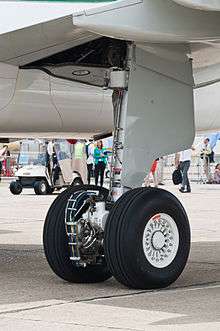EGTS
An Electric Green Taxiing System (EGTS) is an electric taxiing system which allows aircraft to taxi and pushback without requiring the use of aircraft engines, and is designed to reduce fuel volumes used by aircraft and reduce greenhouse gas emissions during ground operations. EGTS technology enables aircraft to avoid using their main engines during taxiing and instead taxi autonomously under their own electrical power, using the Auxiliary Power Unit (APU) generator. The system is designed for single-aisle aircraft, such as the Airbus A320 and the Boeing 737.

Design
EGTS is an electric taxiing system that is used prior to takeoff and can help airlines reduce costs by eliminating the need to use jet engines which are not efficient on the ground. It can also reduce foreign object damage and is environmentally friendly as it reduces carbon and other emissions created during the taxiing phase. The main landing gear is equipped with an electric motor powered by the auxiliary power unit which allows the aircraft to push back from the gate and taxi without a tug or its jet engines.[1]
The system weighs 300 kilograms (660 lb) and is permanently installed on the aircraft.[2] The system can accelerate the aircraft to 20 knots (37 km/h; 23 mph).[3]
With electric motors located on each of the main landing gear driving inboard wheels and powered by the APU generator, the EGTS system allows aircraft to push back from the gate without a tug tractor and taxi without the use of the main engines.
The Pilot Interface Unit enables the pilot to switch on the EGTS and select the desired taxi speed (forward) or push back speed (backwards). The EGTS controller receives and converts the pilot's directives into orders to power the electronics.
The wheel actuator applies the required torque and speed proportional to the wheel as per the instructions received from the Wheel Actuator Controller Unit (WACU). The WACU converts current into instructions to the electrical motor proportional to the pilot's command as delivered by the EGTS controller.
Development
Electric taxiing was invented by Delos Aerospace in 2003,[4] and patented in 2006.[5]
Honeywell and SAFRAN announced their joint venture EGTS International at the Paris Air Show in 2011.[2]
In 2012, easyJet, in collaboration with Honeywell and Safran, announced that it would be the first airline to support the development and trial of the electric green taxiing system (EGTS).[6]
Following the initial phase of ground testing and first move in April 2013, the system was first demonstrated at the Paris Air Show 2013.[7]
In June 2013, Air France announced its support of the development of the EGTS taxiing system.[8]
In December 2013, Airbus signed a memorandum of understanding (MoU) with EGTS International to further develop and evaluate EGTS for the A320 Family.[9]
In March 2014, Honeywell and Safran signed a Memorandum of Understanding with GoAir to support the advancement of the EGTS taxiing system.[10] GoAir will test the system and supply operational data to have an accurate projection of fuel saving to potential customers.[11]
In April 2014, Mexican airline Interjet became the first North American airline to announce its support for the advancement of the EGTS taxiing system,[12]
At Farnborough Air Show in July 2016, while the development was successful and customers were interested, Honeywell terminated its joint venture with Safran with low oil prices sapping its market but Safran will continue to work on taxiing systems as system design was completed while its A320 demonstrator had been decommissioned since 2013.[13]
In July 2017, to promote it in China, Safran signed a Memorandum of Understanding with a subsidiary of China Aviation Supplies.[14]
Competition
Competitor Taxibot is the only certified and operational alternative taxiing system in the market; it is a semi robotic tractor which meets the aircraft for taxi-in and taxi-out, once connected it is controlled by the pilot. Competing products in development by WheelTug are different as they are installed on the nose gear.[3]
In 2011, L-3 Communications trialled a similar main landing gear electric taxiing system on an A320 non-flyable demonstrator with Lufthansa Technik and others, and proposed to develop the eTaxi system with Crane Aerospace but abandoned its plans in 2013 due to high investment costs.[13] Another competitor is WheelTug, whose patent describes it as a drive motor inside the nose wheels. Wheeltug hopes to enter service in 2018 when it hopes to obtain initial certification on the Boeing 737.[13]
References
- "EGTS brochure".
- Bill Carey (June 18, 2013). "Honeywell, Safran Demo Electric Taxiing System For Airlines". AIN.
- "WheelTug, Safran-Honeywell and IAI Offer Three Rival Solutions for Airline Engine-off Taxiing". AIN. 11 February 2014.
- "What We Do". Delos Aerospace.
- US7226018, "Landing gear method and apparatus for braking and maneuvering"
- "EasyJet to Test Electric Plane-Taxiing Gear to Reduce Fuel Burn". Bloomberg.
- "Paris Air Show: Aircraft tech that works best on the ground". BBC. 21 June 2013.
- "Air France helps to develop the Electric Green Taxiing System" (Press release). Air France.
- "Airbus signs MoU with Honeywell and Safran to develop electric taxiing solution for A320 Family" (Press release). Honeywell. Archived from the original on 2014-09-16. Retrieved 2014-09-16.
- "GoAir signs pact with Honeywell, Safran for tech to save fuel". The Hindu Business Line.
- Research, Zacks Investment. "Honeywell & Safran Sign MOU for EGTS". Zacks.com. Retrieved 17 March 2017.
- "Interjet becomes the first american airline to support electric taxiing system" (Press release). Safran. Archived from the original on 2014-08-24. Retrieved 2014-09-16.
- Michael Gubisch (13 July 2016). "Honeywell and Safran halt electric taxi project". Flightglobal.
- Henry Canaday (Aug 4, 2017). "Saving Taxi & Pulling Power". Aviation Week Network.